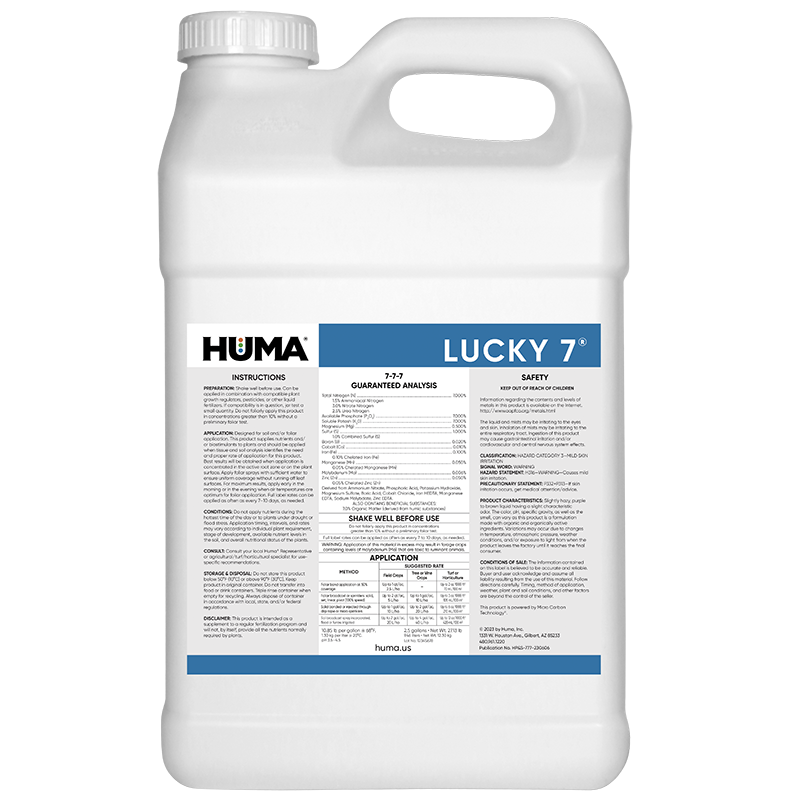LUCKY 7
Benefits of Use:
- “Leaf friendly” to ensure maximum uptake and translocation
- Stimulates root growth in seedlings and transplants
- Improves overall plant nutrient value and vigor by increasing essential nutrient levels
- Excellent balanced nutrient blend for all crops
- Complete macro- and micronutrients in complexed form for easy, rapid uptake
- Blended for all soil types and regions
- Improves tolerance to environmental stresses
- Excellent product for fertigation
FAQs
Related Videos
Huma Gro Lucky 7: Macronutrient Product
Complete balanced nutrition in one product. A 7-7-7 macronutrient liquid fertilizer with many essential micronutrients. Contains Magnesium, Sulfur, Boron, Cobalt, Iron, Manganese, Molybdenum, and Zinc micronutrients. Developed for all soil types and regions. Stimulates root
Learn More
Related Products
Related Case Studies

Huma® Program Increases Marketable Strawberry Yields 19%, With an ROI > $5,000/acre
Objective This field trial assessed the effects of an additional 8 foliar applications of Huma® products throughout the growing season on the yield of Monterey strawberries when compared with the grower’s standard crop nutrition program. Materials & Methods This trial was set up in a complete randomized-block design conducted during the growing season of April

Huma® Program Increases Strawberry Yields 14%, With an ROI > $2,500/acre
Objective This field trial assessed the effects of Promax® and Zap® on top of fumigation—plus additional foliar applications of 4 Huma® fertilizer products—on the yield of Portola strawberries when compared with the grower’s standard crop nutrition program. Materials & Methods This trial was set up in a complete randomized-block design conducted during the growing season

Huma® Program Increases Soybean Yields 21%, With an ROI of 389%
Objective This field trial assessed the effects of 2 foliar applications of 2 combinations of Huma® products versus a control during the growing season on the yield of soybeans (Glycine max, variety AG48X7) when compared with the grower’s standard crop nutrition program. Materials & Methods This trial was set up in a complete randomized-block design
Related Blog Posts

This Week in Ag #11
You shouldn’t judge a book by its cover, but you can judge seed products by their bag covers. There’s lots of telling information on them. Just look at this bag of seeds going on my farm. The bag itself prominently features the brand name and logo (AgriGold), type of product (corn), the actual product name (A647-79VT2PRO) and

This Week in Ag #68
How many kernel rows, or rounds, will an ear of corn have? That’s being determined right now in my cornfield. My corn has hit the critical V6 growth stage (in just 31 days, no less). Next to emergence and pollination, V6 is one of the most significant times of the plant’s life. This is when the

The Immortal Words of a Corn Legend
"Any corn plant that doesn’t emerge within 12 hours of others is a weed.” Immortal words from an immortal farmer. My friend Steve Albracht. The brash Texan certainly had a way with words. And with corn. I called him the Ric Flair of corn growers – he held as many National Corn Growers Association (NCGA) yield contest titles as Flair has wrestling championships. And he was just as bold. Visiting his Hart, Texas, farm was akin to visiting that of Francis Childs or Roswell Garst. Fast, uniform crop emergence and singulation weren’t just a goal; it was his obsession. He wanted every plant in the entire field to emerge within eight hours. Studies show that plants emerging 24 hours later can lose up to 25% of their yield. While some corn hybrids may be called racehorses, they don’t close on each other like racehorses do. Slow emergers and runt plants will never catch up to early risers.






